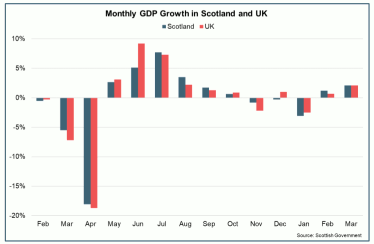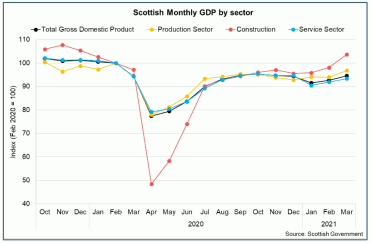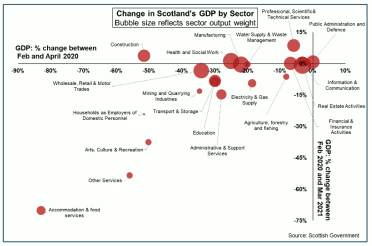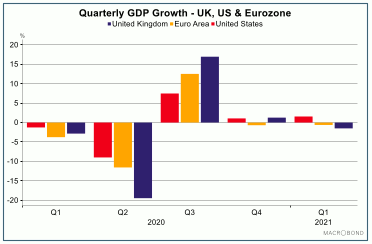Monthly economic brief: May 2021
The monthly economic brief provides a summary of latest key economic statistics, forecasts and analysis on the Scottish economy.
This document is part of a collection
Output
Footnote [1]
Scotland’s GDP fell 2.1% in the first quarter of 2020 during lockdown, however on a monthly basis output returned to growth in February and strengthened into March.
- Scotland’s GDP fell by 2.1% in Q1 2021 during the recent lockdown restrictions (UK: -1.5%). This is significantly less than the 18.5% fall in Q2 2020 during the national lockdown last year reflecting the differences in lockdown restrictions in place, the reduced capacity at which some parts of the economy were already operating at and growth in other sectors of the economy as businesses and consumers have adapted to operating under restrictions.
- The fall in GDP during Q1 2021 was primarily due to reduced output in parts of the services sector most impacted by the lockdown restrictions, with the largest reductions in accommodation and food services, other personal services (such as hair dressers) and in education due to schools conducting remote learning for most of the quarter. Overall, services sector output fell by 3.1% compared to Q4 2020, while construction sector output increased by 3.1%, and production sector output by 1.1%.
- The monthly GDP data suggests that the fall in output in the first quarter of 2021 was confined to January (-3.1%) with output growing over February (1.2%) and March (2.1%). In March, lockdown restrictions continued for consumer-facing services such as hospitality and non-food retail, while there was a boost to output from all primary school year groups returning to school and there was growth across the production and construction sectors.
Scottish Monthly GDP Growth in Scotland and UK 
- Overall, growth was broad based in March across the services (1.6%), production (3.0%) and construction (5.7%) sectors, as progress back to pre-pandemic levels strengthened for a second month following the period of falling output between November and January as restrictions tightened.
- At its lowest point in April 2020, Scotland’s GDP fell to 22.6% below its pre-pandemic level in February 2020 and at March 2021, GDP is partly recovered back to 5.4% below its pre-pandemic level (UK: -5.9%).
Scottish Monthly GDP by Sector 
- However there remain significant differences across sectors in the scale of the initial fall in output in March and April 2020 during national lockdown and in the pace of recovery across sectors since then, which has largely reflected the nature of restrictions over the course of the year.
Change in Scotland’s GDP by Sector 
- Manufacturing output fell 22% between February and April 2020, however in March, manufacturing output had recovered to 0.5% below its pre-pandemic level in February, while construction output fell 51.6% initially and in March had recovered to 3.7% above its pre-pandemic level.
- Consumer facing parts of the services sector however have been more directly impacted by restrictions on activity over the course of the year, and particularly during the recent restrictions over the winter months. For example, accommodation and food services output fell 83% between February and April 2020 and following some recovery over summer 2020, sector output fell 62% between September 2020 and February 2021, and in March, remained 70% below its pre-pandemic level. Similarly arts, culture and recreation output in March remained 38% below its pre-pandemic level, having fallen 50% initially between February and April 2020.
- The overall pattern of Scottish GDP during the pandemic has broadly been in line with the UK as a whole. Differences between months and across countries largely reflect differences in the structure of economies and the stringency and timing of restrictions, while differences in how components of GDP are calculated across countries make international comparisons complex.
- Overall global growth slowed in the first quarter of 2021 reflecting the restrictions implemented in the face of the second wave of the virus, however differences were evident across countries and regions. For example, US GDP continued to recover in the first quarter of 2021, growing 1.6% and is back to 0.9% below its pre-pandemic level (Q4 2019), while Euro Area GDP contracted for a second consecutive quarter (-0.6%) and is 5.5% below its pre-pandemic level.
Quarterly GDP Growth – UK, US & Eurozone 
Contact
Email: OCEABusiness@gov.scot
There is a problem
Thanks for your feedback